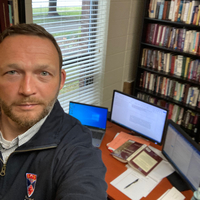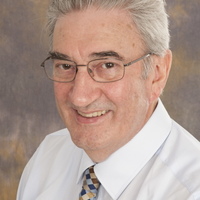
Nathan Johnson
Professor of Moral Philosophy and Liberal Arts at New College Franklin.
Head of Program at New College Franklin
Ph.D. Humanities (Emphasis in Literature) candidate, Faulkner University
M.A. Liberal Arts, St. John's College
M.A. Biblical Studies, Reformed Theological Seminary, Charlotte, NC
M.A. Theological Studies, Reformed Theological Seminary, Charlotte, NC
B.A. English Literature, Bryan College
Head of Program at New College Franklin
Ph.D. Humanities (Emphasis in Literature) candidate, Faulkner University
M.A. Liberal Arts, St. John's College
M.A. Biblical Studies, Reformed Theological Seminary, Charlotte, NC
M.A. Theological Studies, Reformed Theological Seminary, Charlotte, NC
B.A. English Literature, Bryan College
less
Related Authors
Don Collett
Trinity Episcopal School for Ministry
Matthew McAffee
WELCH COLLEGE
Kyle C Dunham
Detroit Baptist Theological Seminary
JiSeong James Kwon
University of Zurich, Switzerland
Alexandru Mihaila
University of Bucharest
Ernest C Lucas
Bristol Baptist College
Joseph Fernandes
University of Oxford
andrew fuyarchuk
Yorkville University
InterestsView All (19)










Uploads
Papers by Nathan Johnson
Murphy rightly notes that, “personified Wisdom is simply unequalled in the entire Old Testament.” Lady Wisdom is one of the most exalted and significant figures in Old Testament theology, so she cannot be ignored. Yet often the debates surrounding the meaning of particular words or ANE origins of the Wisdom concept often lead to more confusion and distract from the clear messages embedded within the text. Scholars both liberal and conservative often fail to attend to Lady Wisdom’s call because they press Lady Wisdom to answer questions about ontology, theology, or Christology that she refuses to answer. When understood properly, Lady Wisdom’s self-revelation focuses not so much on who Lady Wisdom is, but on what Israel was supposed to be, and thus through her self-description, Lady Wisdom calls her ancient readers to do as she says and be who she is. She does not clearly define herself as a person, force, or attribute in order to provide the broadest challenge possible to her readers to imitate her and listen to her. Understood within this context, Lady Wisdom’s stature as example and type of Israel also renders her one of the most profound Christ-types in the Old Testament. This paper will seek to survey the general approaches taken toward understanding Lady Wisdom’s self-description in Proverbs 8:22-31 and will contend that Lady Wisdom describes herself as the ideal type of Israel and also a type of Christ, giving credibility to her message and infusing her with redemptive-historical significance.
In order to answer these questions, one must explore the character of Alyosha before this pivotal moment and trace the events that led to his transition from a “weak youth” into a hero. The brief preface, which features a sort of letter “from the author,” seems to indicate that the narrator considers this book primarily a “biography” of Alyosha, one he considers “my hero” (3). Yet he quickly acknowledges that the reader may not share his opinion of Alyosha’s heroic stature, admitting that Alyosha is “of an indefinite, indeterminate sort,” one who may seem more “odd” or “strange” than heroic and noteworthy (3). Nevertheless, the narrator maintains that an odd man may in fact stand outside the ordinary while nonetheless “bearing within himself the heart of the whole,” intimating that Alyosha as hero may somehow bear the heart of the world, or at least the heart of his society (3). It is not clear from this brief note what exactly it means for Alyosha to bear within himself the heart of the whole—it could be the contemporary zeitgeist or it could be the experience and suffering of society or something else entirely. But whatever it means, the narrator seems to indicate that to understand Alyosha’s heroic stature, we must understand that in some way he bears within himself the heart of the whole, and in some way this will be illustrated in the book and will be connected with his heroic stature.
In his A Theatre of Envy, Rene Girard explores this question through his explication of The Winter’s Tale’s unique perspective on the tragic problem of mimetic desire, laying bear its brilliant exploration of the tragic consequences of mimetic desire and also the means by which it can die so that man might live again. Through a close evaluation of key scenes in the play, Girard reveals how mimetic rivalry is at the center of Leontes’ tragic fall and how recognition, repentance, renunciation, and forgiveness bring about an unprecedented resurrection of Leontes’ own soul by putting mimetic rivalry and jealousy to death. In the spirit of Girard, this essay will explicate Girard’s interpretation of The Winter’s Tale and further his own interpretation of the play by exegeting the important early scenes that reveal the very cure Girard reveals in Acts 4-5.
One of the most pressing questions surrounding the implications of non-Euclidean geometry relates to what bearing this has on the nature of truth and beauty. Does it indicate that truth is relative or, at least, non-objective or pluralistic? Does it indicate that there are many truths or that truth is a human construct? And since mathematics seems to have direct relationship with beauty, does non-Euclidean geometry indicate that beauty is subjective or malleable? Could it be that, in fact, the creation (or discovery?) of non-Euclidean geometry liberates truth and beauty from a metaphorically flat plane into a three-dimensional sphere of complexity, depth, and paradox? These questions must be addressed, even if they cannot be fully answered.
Drafts by Nathan Johnson
Murphy rightly notes that, “personified Wisdom is simply unequalled in the entire Old Testament.” Lady Wisdom is one of the most exalted and significant figures in Old Testament theology, so she cannot be ignored. Yet often the debates surrounding the meaning of particular words or ANE origins of the Wisdom concept often lead to more confusion and distract from the clear messages embedded within the text. Scholars both liberal and conservative often fail to attend to Lady Wisdom’s call because they press Lady Wisdom to answer questions about ontology, theology, or Christology that she refuses to answer. When understood properly, Lady Wisdom’s self-revelation focuses not so much on who Lady Wisdom is, but on what Israel was supposed to be, and thus through her self-description, Lady Wisdom calls her ancient readers to do as she says and be who she is. She does not clearly define herself as a person, force, or attribute in order to provide the broadest challenge possible to her readers to imitate her and listen to her. Understood within this context, Lady Wisdom’s stature as example and type of Israel also renders her one of the most profound Christ-types in the Old Testament. This paper will seek to survey the general approaches taken toward understanding Lady Wisdom’s self-description in Proverbs 8:22-31 and will contend that Lady Wisdom describes herself as the ideal type of Israel and also a type of Christ, giving credibility to her message and infusing her with redemptive-historical significance.
In order to answer these questions, one must explore the character of Alyosha before this pivotal moment and trace the events that led to his transition from a “weak youth” into a hero. The brief preface, which features a sort of letter “from the author,” seems to indicate that the narrator considers this book primarily a “biography” of Alyosha, one he considers “my hero” (3). Yet he quickly acknowledges that the reader may not share his opinion of Alyosha’s heroic stature, admitting that Alyosha is “of an indefinite, indeterminate sort,” one who may seem more “odd” or “strange” than heroic and noteworthy (3). Nevertheless, the narrator maintains that an odd man may in fact stand outside the ordinary while nonetheless “bearing within himself the heart of the whole,” intimating that Alyosha as hero may somehow bear the heart of the world, or at least the heart of his society (3). It is not clear from this brief note what exactly it means for Alyosha to bear within himself the heart of the whole—it could be the contemporary zeitgeist or it could be the experience and suffering of society or something else entirely. But whatever it means, the narrator seems to indicate that to understand Alyosha’s heroic stature, we must understand that in some way he bears within himself the heart of the whole, and in some way this will be illustrated in the book and will be connected with his heroic stature.
In his A Theatre of Envy, Rene Girard explores this question through his explication of The Winter’s Tale’s unique perspective on the tragic problem of mimetic desire, laying bear its brilliant exploration of the tragic consequences of mimetic desire and also the means by which it can die so that man might live again. Through a close evaluation of key scenes in the play, Girard reveals how mimetic rivalry is at the center of Leontes’ tragic fall and how recognition, repentance, renunciation, and forgiveness bring about an unprecedented resurrection of Leontes’ own soul by putting mimetic rivalry and jealousy to death. In the spirit of Girard, this essay will explicate Girard’s interpretation of The Winter’s Tale and further his own interpretation of the play by exegeting the important early scenes that reveal the very cure Girard reveals in Acts 4-5.
One of the most pressing questions surrounding the implications of non-Euclidean geometry relates to what bearing this has on the nature of truth and beauty. Does it indicate that truth is relative or, at least, non-objective or pluralistic? Does it indicate that there are many truths or that truth is a human construct? And since mathematics seems to have direct relationship with beauty, does non-Euclidean geometry indicate that beauty is subjective or malleable? Could it be that, in fact, the creation (or discovery?) of non-Euclidean geometry liberates truth and beauty from a metaphorically flat plane into a three-dimensional sphere of complexity, depth, and paradox? These questions must be addressed, even if they cannot be fully answered.